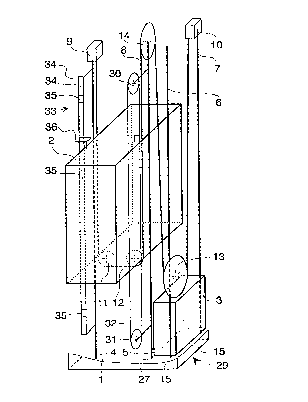Some of the information on this Web page has been provided by external sources. The Government of Canada is not responsible for the accuracy, reliability or currency of the information supplied by external sources. Users wishing to rely upon this information should consult directly with the source of the information. Content provided by external sources is not subject to official languages, privacy and accessibility requirements.
Any discrepancies in the text and image of the Claims and Abstract are due to differing posting times. Text of the Claims and Abstract are posted:
| (12) Patent: | (11) CA 2199966 |
|---|---|
| (54) English Title: | ARRANGEMENT FOR FIXING AN ELEVATOR ROPE |
| (54) French Title: | DISPOSITIF DE FIXATION D'UN CABLE D'ASCENSEUR |
| Status: | Term Expired - Post Grant Beyond Limit |
| (51) International Patent Classification (IPC): |
|
|---|---|
| (72) Inventors : |
|
| (73) Owners : |
|
| (71) Applicants : |
|
| (74) Agent: | G. RONALD BELL & ASSOCIATES |
| (74) Associate agent: | |
| (45) Issued: | 2000-05-23 |
| (86) PCT Filing Date: | 1995-09-27 |
| (87) Open to Public Inspection: | 1996-04-04 |
| Examination requested: | 1997-07-17 |
| Availability of licence: | N/A |
| Dedicated to the Public: | N/A |
| (25) Language of filing: | English |
| Patent Cooperation Treaty (PCT): | Yes |
|---|---|
| (86) PCT Filing Number: | PCT/FI1995/000530 |
| (87) International Publication Number: | WO 1996009978 |
| (85) National Entry: | 1997-03-13 |
| (30) Application Priority Data: | ||||||
|---|---|---|---|---|---|---|
|
According to the invention, at least one end of the elevator ropes (8) is
fixed to a guide rail (4, 7) of the elevator. According to an embodiment of
the invention, the whole elevator is so suspended by its ropes (8) that all
vertical forces are transmitted by the guide rails (4...7) to the bottom (27)
of the shaft (1). The invention provides the advantages that the elevator is
easy to install and that the vertical forces are transmitted by the guide
rails (4...7) to the bottom (27) of the shaft (1), permitting a lighter
construction of shaft walls.
Selon l'invention une extrémité au moins du câble (8) de l'ascenseur est fixée aux rails (4, 7) de guidage de l'ascenseur. Dans l'une des variantes de l'invention, l'ensemble de l'ascenseur est suspendu par ses câbles (8) de manière telle que toutes les forces verticales soient transmises par les rails de guidage (4...7) à la base (27) de la cage (1). L'invention présente des avantages en matière de simplicité d'installation et de transmission des forces verticales par les rails de guidage (4...7) à la base (27) de la cage (1), ce qui permet une construction plus légère des parois de la cage.
Note: Claims are shown in the official language in which they were submitted.
Note: Descriptions are shown in the official language in which they were submitted.

2024-08-01:As part of the Next Generation Patents (NGP) transition, the Canadian Patents Database (CPD) now contains a more detailed Event History, which replicates the Event Log of our new back-office solution.
Please note that "Inactive:" events refers to events no longer in use in our new back-office solution.
For a clearer understanding of the status of the application/patent presented on this page, the site Disclaimer , as well as the definitions for Patent , Event History , Maintenance Fee and Payment History should be consulted.
| Description | Date |
|---|---|
| Inactive: Expired (new Act pat) | 2015-09-27 |
| Inactive: IPC from MCD | 2006-03-12 |
| Inactive: IPC from MCD | 2006-03-12 |
| Inactive: IPC from MCD | 2006-03-12 |
| Grant by Issuance | 2000-05-23 |
| Inactive: Cover page published | 2000-05-22 |
| Pre-grant | 2000-02-22 |
| Inactive: Final fee received | 2000-02-22 |
| Notice of Allowance is Issued | 1999-09-01 |
| Letter Sent | 1999-09-01 |
| Notice of Allowance is Issued | 1999-09-01 |
| Inactive: Approved for allowance (AFA) | 1999-07-22 |
| Letter Sent | 1997-11-06 |
| Letter Sent | 1997-10-14 |
| Inactive: IPC assigned | 1997-08-12 |
| Inactive: IPC assigned | 1997-08-12 |
| Inactive: First IPC assigned | 1997-08-12 |
| Request for Examination Received | 1997-07-17 |
| Request for Examination Requirements Determined Compliant | 1997-07-17 |
| All Requirements for Examination Determined Compliant | 1997-07-17 |
| Inactive: Single transfer | 1997-05-05 |
| Inactive: Courtesy letter - Evidence | 1997-04-08 |
| Application Published (Open to Public Inspection) | 1996-04-04 |
There is no abandonment history.
The last payment was received on 1999-09-20
Note : If the full payment has not been received on or before the date indicated, a further fee may be required which may be one of the following
Please refer to the CIPO Patent Fees web page to see all current fee amounts.
Note: Records showing the ownership history in alphabetical order.
| Current Owners on Record |
|---|
| KONE OY |
| Past Owners on Record |
|---|
| ESKO AULANKO |
| HARRI HAKALA |
| JORMA MUSTALAHTI |